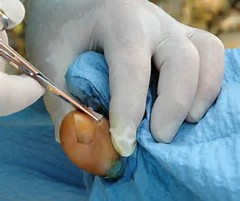More from suncoastpodiatry suncoastpodiatry
More in Politics
Related Blogs
Archives
Social Share
What Is The Best Way To Get Rid Of An Ingrown Toenail?
Posted By suncoastpodiatry suncoastpodiatry
Body
An ingrown toenail is a painful condition that most people try to treat on their own. Before you try a home remedy, keep in mind that self-treatments can delay the recovery process. So to prevent the risk of infections or reoccurrence, it is best to let a foot doctor treat your ingrown toenails.
The internet is filled with videos and stories where people tell you they have successfully treated their ingrown toenails at home. Fortunately, not all of these stories are fake; in some cases, self-treatment is possible as well as convenient. However, if the toenail is infected you had better not mess with it and should book an appointment at a foot and nail clinic.
In this post, we will discuss some easy ways to self-assess your ingrown toenails. Using this guide, you can decide when to see a podiatrist and when to try at-home remedies.
What causes ingrown toenails and how do they look?
An ingrown toenail is a condition, where the toenail curls back into the skin. Sometimes the surrounding skin mounts on the nail bed and creates discomfort. The easiest way to spot a toenail is curling or digging into the skin , apart from that redness, swelling, inflammation and discomfort, is to inspect your toes regularly.

Your toenails can get painful and tender at any age. The key factors contributing to the problem are improper foot hygiene, improper nail trimming, ill-fitted shoes or an injury.
Some people are more susceptible to ingrown toenails than others. If you are one of them, then it is important to get timely treatments because when left ignored, the curled toenail can break inside the skin and become a breeding ground for bacteria.
How to treat ingrown toenails at home?
Thinking that your ingrown toenail will fix itself is not going to work. You should start ingrown toenail treatment as soon as you notice it. It will reduce the risk of serious fungal infection that even leads to amputations.
If the toenail is not infected yet, you can try some at-home remedies to treat it. Beware, never ever try to perform the surgery on your own. The self-care tips suggested below are just for the preliminary stages: severe conditions should only be treated by an expert.
- Take pain relief medication
- Soak your foot in salt water for fifteen minutes
- Gently pull the skin to make some gap between the skin and the toenail
- Use an antibiotic ointment and wrap the toenail in a bandage
- Wear comfortable shoes
- Keep the foot dry except when it is soaking time
When to see a doctor for an ingrown toenail?
Ingrown toenails can be treated safely in the early stages. When doing the home remedies, you need to keep checking for any signs of infection. If the redness and swelling are increasing, make sure the site is not infected. When infection causing bacteria enters the skin, it results in a foul smell or you may see pus coming out.
Immediately seek professional consultation if your toenail is infected. The longer you wait, the more complicated the treatment procedure will be.
In addition to this, some people can easily treat ingrown toenails at home but are frustrated with the reoccurrence. If you are one of them, then stop treating your toenails at home and have a word with a podiatrist who can help you get rid of the ingrown toenail permanently.
What to expect at a podiatrist appointment for an ingrown toenail?
Ingrown toenails are treated via a surgical procedure. During this procedure, the curled part of the nail plate is removed. It is the topmost part of your toenail that sits on top of the nail bed, usually on the edge or side Ingrown toenail surgery is helpful in preventing the reoccurrence and it also reduces the risk of infections. The key points that you need to know about the treatment are listed below:
- It is a minor surgery and it won’t involve stitching or cutting of the skin
- The entire procedure takes about an hour.
- You won’t feel any pain as the surgery is performed after numbing the site.
- The doctor cuts the ingrown toenail, removes the excess, treats it to prevent it regrowing and puts a sterile dressing on top.
- The recovery period is around two to four weeks.
Are there any complications of toenail removal surgery?
Ingrown toenail surgery is a non-invasive procedure. It is a risk free procedure. The risk of complications is minimal, though the surgery is not a viable solution with some medical conditions. Podiatrists can assess your condition, examine your medical history and decide if it’s a safe choice for you.
Ingrown toenails should be treated in a timely manner to reduce the risk of severe infections. Surgery is the safest and most effective way to get rid of ingrown toenails. It is a pain-free procedure and gives freedom from the reoccurrence of ingrown toenails.
To learn more about the process of ingrown toenail treatment, visit Suncoast Podiatry. It is a leading group podiatry practice that is providing quality services for general podiatry and sports podiatry across Noosa, Cooroy, Bli Bli and Gympie.











Comments